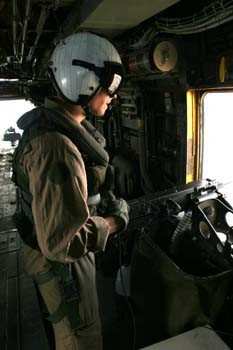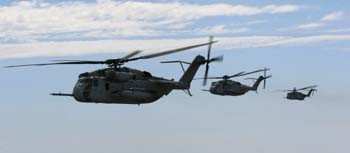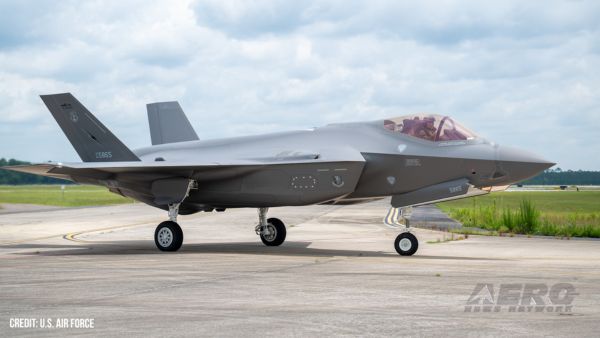Marine Helo Teams Train For Iraq Deployment
 Before every big show, actors,
actresses, stage crew and the director rehearse for days on end,
perfecting the timing and delivery of all dialogue and production
to ensure the show goes on as a hit. If pieces of the puzzle are
not running efficiently and cohesively, other sections can not
successfully complete their job to the best of their ability.
Before every big show, actors,
actresses, stage crew and the director rehearse for days on end,
perfecting the timing and delivery of all dialogue and production
to ensure the show goes on as a hit. If pieces of the puzzle are
not running efficiently and cohesively, other sections can not
successfully complete their job to the best of their ability.
In the same respect, before deploying to the theater of Iraq,
squadrons must rehearse operations in combat-simulated a training
environment here in the US. Before the curtain goes up on a
deployment, Miramar squadrons will have had ample amount of
practice with one another to ensure each knows their role in combat
operations.
In the skies over California August 30, Marines with Marine
Heavy Helicopter Squadron 462 and Marine Heavy Helicopter Squadron
361 participated in an integration exercise designed to familiarize
the two squadrons with one another.
Integration exercises are designed for pilots and air crews to
work synonymously with other squadrons to perfect the operations
they will be conducting during upcoming deployments. The scenarios
allow for pilots and air crews to learn each other's habits and
tendencies, allowing for greater success while in country.
"These types of training missions are done to prepare pilots and
aircrews to operate in environments similar to what they will see
while deployed to Iraq," said Capt. Blair J. Garner, a pilot and
future operations officer with HMH-462. "Temperature and dust are
two extremes we have no control over so practicing landing in small
area's with these conditions will help when we are required to do
it for real."
Another of the missions involved in the training exercises
includes practicing divisional tactics.
Divisional tactics involve maneuvering several aircrafts in sync
with one another, which requires training for all crews involved.
The pilots stay in ready communication with their crew chiefs to
remain informed of all activity around them in order to be
completely effective.
Many of these tactics involve close-quarter landings and
tactical airborne formations, which can be dangerous if not
properly executed.
"Communication between pilots and crew chiefs plays an essential
role in the success of the mission," said Cpl. John Husbands, a
CH-53E crew chief with HMH-361. "Because the pilots have no idea
what's happening inside, behind or underneath the aircraft, we
inform them of all activity and positions of all other aircraft in
the vicinity."
Other activities include enemy contact from the air or ground
and the assault element assigned to escort the aircraft to and from
their destination.
"Integration of units is important because you have to train to
the standard of going into unfriendly places with units you don't
often work with," said Capt. Tyler Leonard, a pilot with HMH-462.
"It's important for us to go out and keep up our training, which
gives a good idea on what we will encounter and who we'll be
working with to get the job done while in Iraq."
The Super Stallion comes equipped with two window-mounted M2 .50
caliber machine guns, with the ability to mount a third to the rear
hatch of the aircraft.
Much like ground troop movements and mounted combat patrols, the
crew is informed of their sector of fire to not inadvertently fire
rounds at their own men. Flying in tactical formations also allows
for security on all flanks.
By rehearsing these situations, the Marines manning these
weapons know the location of the other aircrafts, preventing
friendly fire.
The Department of Defense promotes the use of joint service
integration training by conducting operations such as Valiant
Shield. The training operation in 2007 included more than 30 ships,
280 aircraft and 20,000 service members from the Air Force, Coast
Guard, Navy and Marine Corps.

The exercise, which was held in the Guam operating area, tested
the ability to manage shared air space and train for future
operations in the area. After all... becoming familiar with those
you work with and having trust in them to complete their job, will
save from suffering stage fright when the show goes live.
(Aero-News salutes Lance Cpl. Michael R. Stevens, MCAS
Miramar.)
 Airborne 08.22.25: ARC Spinoff, Nat'l Championship Air Races, Hawkins Accident
Airborne 08.22.25: ARC Spinoff, Nat'l Championship Air Races, Hawkins Accident Airborne 08.27.25: Air Race Tkt Discounts, Europe AvGas, Deportation Flights?
Airborne 08.27.25: Air Race Tkt Discounts, Europe AvGas, Deportation Flights? Airborne Affordable Flyers 08.28.25: Midwest Av Expo, Vickers, Air Race Classic
Airborne Affordable Flyers 08.28.25: Midwest Av Expo, Vickers, Air Race Classic Aero-News: Quote of the Day (08.30.25)
Aero-News: Quote of the Day (08.30.25) ANN's Daily Aero-Term (08.30.25): Low Approach
ANN's Daily Aero-Term (08.30.25): Low Approach




